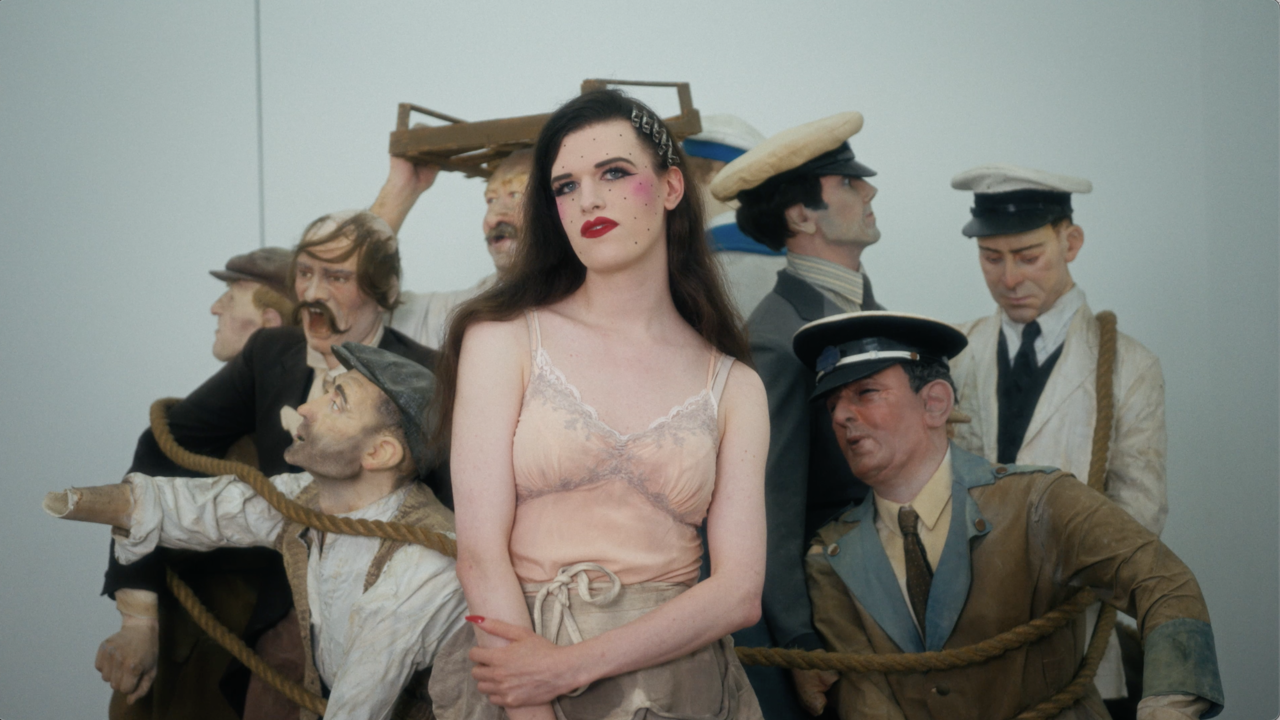Stuart Ringholt
Embarrassment and abnormality; rearranged faces and rotating horizons
Embarrassment and abnormality; rearranged faces and rotating horizons

The great Kurt Vonnegut once wrote: ‘Humor is a way of holding off how awful life can be, to protect yourself.’ I have a suspicion that Australian artist Stuart Ringholt might agree. In Ringholt’s most recent video, Helen Lane (2009), which was filmed in a lane outside his North Melbourne studio, a thin man precariously grasps at the handle of a ‘Wacka-Packa’, (a powerful motorized device typically used for compacting earth on construction sites), that thuds across the lane releasing shards of cobblestone and sending the tree attached to its top into orgasmic quivers. The yet un-exhibited video is, quite simply, absurd, but as such it offers light relief from these trying times.
Ringholt has a knack for combining deadpan earnestness with slapstick humour, and the ability to repurpose and morph objects that normally have no business conversing in order to rid them of their familiar associations. This is particularly evident in his sculptural work, which includes a series of bound books developed from existing publications, such as a volume of photographs of American soldiers, the history of Barbie or a weighty Alberto Giacometti anthology. Ringholt laboriously creates orifices where none should exist, attaching random facial features or, in the case of Giacometti, redesigning the artist’s sculptures so they float in mid-air.
For a solo show last year at Anna Schwartz Gallery in Melbourne, Ringholt exhibited a series of scattered objects, Untitled (Low Sculpture) #2 (2008), including a mass-produced, dark blue, plastic chair, which had been split in two, had its middle section removed and then bound back together with bolts. The object was for Ringholt simply ‘aesthetically beautiful’ and something that either a ‘very skinny person or a Martian could sit in’. Next to the chair the artist placed an arrow shaft with a foam sausage shoved on its end. Plugged into an electricity socket another arrow shaft was propped upright. These sculptures, however, should not be mistaken for an arte povera inspired exercise attempting to elevate found objects into a higher aesthetic stratosphere. Ask Ringholt where he sources his materials his deadpan answer is simply: ‘an arrow store’ or ‘I ordered them off the internet’.

His reticence makes Ringholt’s work difficult to define. It includes sculpture, video, performance, workshop facilitation and writing; in a nutshell, he uses his art to explore the limits of what is considered normal. In 2006 Ringholt was invited to participate in the 2008 Biennale of Sydney by curator Carolyn Christov-Bakargiev after she had read Ringholt’s manuscript, Hashish Psychosis: What It’s Like to Be Mentally Ill and Recover (2006). The autobiography is an unnervingly honest account of Ringholt’s drug-fuelled descent into mental illness (he has now recovered). First shown in manuscript form for the exhibition ‘NEW05’ at the Australian Centre for Contemporary Art, Melbourne, the autobiography has, for some years, been used as an introduction to the artist’s work. It opens: ‘One night, at the age of 23 I wanted to have sex with my mother’. The suggestion that developing a conceptual art practice was just part of a recovery programme is a recurrent one for Ringholt. What is more, early career performances perpetuate the idea that his practice is cathartic in nature. For example Conceptual Art Improved My Embarrassing Life (2003) involved the artist performing a series of embarrassing actions in public, such as standing in a busy square in Florence with toilet paper sticking out of his pants. Funny Fear Workshops (2004), initially held at Gertrude Contemporary Art Space, saw Ringholt invite visitors to participate in a workshop designed to rid them of their fear of embarrassment by living through the moment in a safe environment. However, to consider this entire practice as mere self-help would be too easy.
Ringholt has stated that his desire to be an artist was sparked, at the age of 20, by watching Michael Snow’s glorious experimental film La Région centrale (The Central Region, 1971). Shot in the Canadian Rocky Mountains over a period of 24 hours using a robotic arm, the film is a kaleidoscope of switching view-points and rotating horizons. Its fascination with oscillating perspectives and alternate realities is a clear influence on Ringholt.
For the Sydney Biennale, Ringholt initially proposed a performance – now a video, Merri Creek (2007) – for which the artist would drop a tall cyprus pine directly into a deep pit. The action, when performed in the video, has a sense of urgency about it, which Ringholt explains is a result of the ‘sudden reversal of the complete growth process of the tree’. Unfortunately the performance did not go ahead as its non-permanent nature was deemed inappropriate for Sydney’s Botanical Gardens. Instead another participatory piece was commissioned: Anger Workshops (2008).
For his forthcoming exhibition at Monash University Museum of Art, Melbourne, ‘To much of me – seven paths through the absurd (with detour)’, Ringholt has been given licence to experiment once again with his sculpture. As curator Geraldine Barlow observes: ‘often the things we laugh at are the most poignant in our lives’. Ringholt assumes the responsibility of living through these dark moments so that others can find a space of mirth. Christov-Bakargiev further suggests this strategy ‘draw[s] the principles of high art closer to a lived life.’ When these principles involve a giant latex rubber elephant foot, which fits perfectly over the Wacka-Packa, propped against Ringholt’s studio wall waiting for an opportunity to see the inside of a gallery space, imagining the outcome one can only hope the ‘high art world’ sees fit to let Ringholt’s ideas keep running.






















